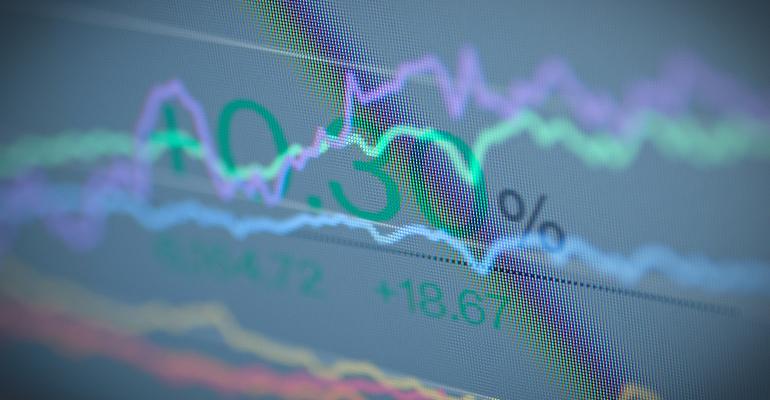(Bloomberg Opinion) -- A global bear market in financial assets has been raging for months and shows few signs of abating. The MSCI global stock index has lost about 22% from its high last autumn. Emerging-market stocks have lost about 30% since their high early last year. But most striking is how badly other assets have done at the same time, notably government and corporate bonds. Indexes of seven-to-10-year US Treasuries and investment-grade corporate debt have lost about 10% and 13% respectively this year. That’s still much better than the lamentable performance of their European counterparts. Yet it is highly unusual for both fixed income and equities to perform so badly at the same time. Since the late 1990s, stocks and bonds have been negatively correlated: If stocks tumbled, bonds tended to go up. What happened?
In February 2021, I wrote that the Federal Reserve had created the biggest financial bubble in history because it encompassed everything. Growing inflationary pressures, I argued, would pop that bubble as the Fed and other central banks would be forced to act. What I should have also pointed out was that the overall valuation of most traditional securities portfolios, which contain a selection of bonds and equities, was without a doubt far and away the highest it had been in history. Those valuations were driven ever higher by central banks’ reaction to the previous two decades of disinflation and their extraordinary and ill-timed reaction to the Covid pandemic.
One way to explain what has been happening for the past few months is pretty straightforward. Inflation has been accelerating more than most people expected, particularly central bankers. It has already eaten into real growth, and as central bankers start to realize that they need to do more to rein it in — perhaps a lot more, which is why the Fed raised rates 75 basis points last week and the Swiss National Bank caught everyone off guard by lifting rates 50 basis points — growth will almost certainly sputter further. High and rising inflation and low and falling growth are a toxic combination for both bonds and equities when their starting valuations were so high.
But I think other subtler and more powerful forces are also at work, ones that ultimately might take years to unwind. Before the late 1990s, correlations between stocks and bonds were broadly positive — they rose and fell in tandem — because, the evidence strongly suggests, investors were worried about inflation. Around the turn of the century, they became more worried about disinflation and growth, and correlations reversed. As inflationary concerns have thrust themselves to the fore in the past couple of years, correlations have once again been flipping positive.
This can have significant results, even in the short term. Although smarter investors will try to hedge extreme events by buying very-low-chance options to protect against extreme scenarios, pretty much every bank, hedge fund and investment firm relies heavily on a risk-management system in which correlations are a key component. That risk-management model is called Value-at-Risk (VaR, for short). At the risk of oversimplifying, if you have two assets in a portfolio, the model will look at the volatility and price performance of those two assets and the correlation between them. If one asset goes up when the other goes down, you get diversification benefits. This means that, for a given lump of capital, a fund manager can have larger positions overall.
But when prices fall, volatility accelerates and those correlations change, causing big losses on both assets when the model assumed a diversification benefit; the investor is forced to reduce exposure to both assets. That is called a VaR shock, and I think that is what we have been seeing over the past few weeks: forced selling by investors who suddenly find they are over their risk limits. That shock will blow over when asset prices have fallen far enough that longer-term investors are happy to wade in. What those levels are is an open question: Everyone has different valuation metrics or needs.
At least two longer-term questions remain, however. The first, in effect, is about the cost of hedging risk positions such as stocks with government bonds. Correlations say nothing about where two assets end up, only how they get there. Over the past couple of decades, holding government bonds was the ultimate hedge because, until 2020, the price only rose over time. Investors made money from both asset classes. Since the middle of 2020, however, extreme inflationary pressures in many countries have led to sharp losses. I would have thought that, unless inflation starts to fall far more than markets expect, most government bonds still look expensive and ripe for further losses. In any case, how much are investors willing to pay for hedges that aren’t working?
The second question is more subtle but perhaps more powerful. When stocks are well diversified with bonds, demand for both rises, driving valuations for each higher on a stand-alone basis. To truly constrain inflation, central banks would need to lift rates far more than markets now expect, pushing countries into severe recessions — the so-called sacrifice ratio. Because I doubt they have the stomach or the political backing for this, I would think it is likely that, although it will ebb and flow, inflation will persist as a rumbling problem for some time. Since that means correlations are likely to stay positive, stand-alone valuations are likely to fall further.
To contact the author of this story:
Richard Cookson at [email protected]





